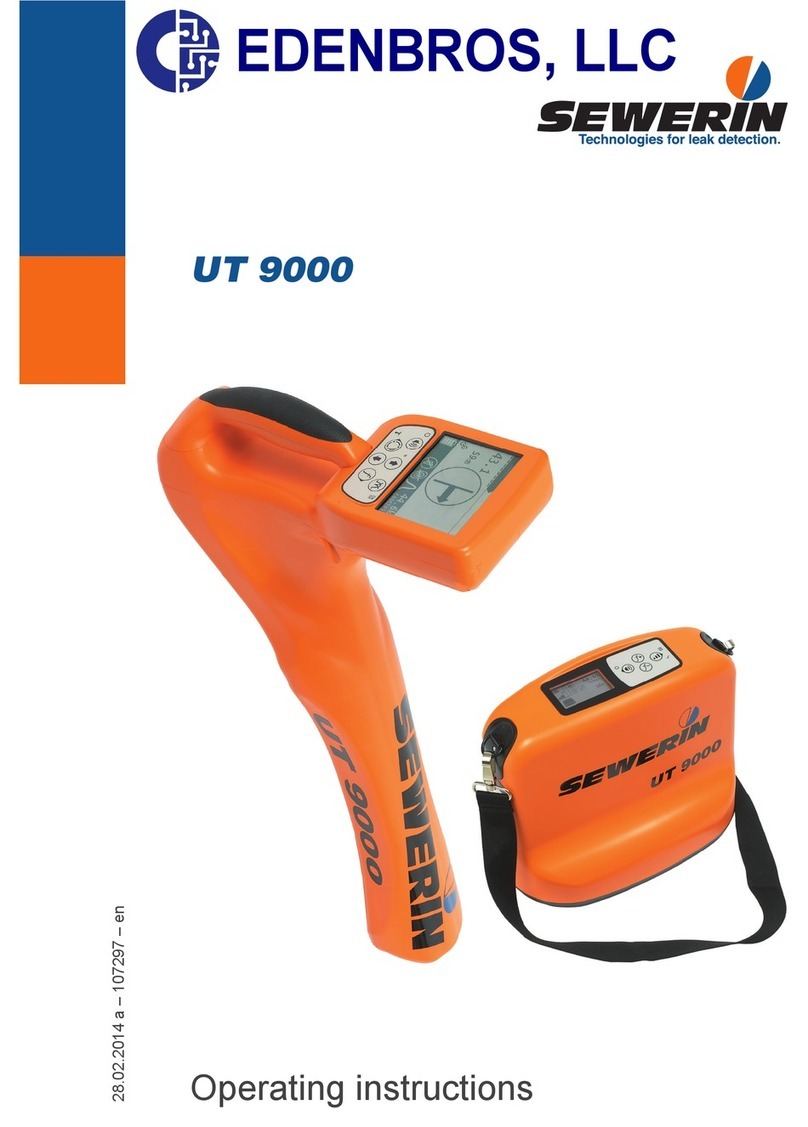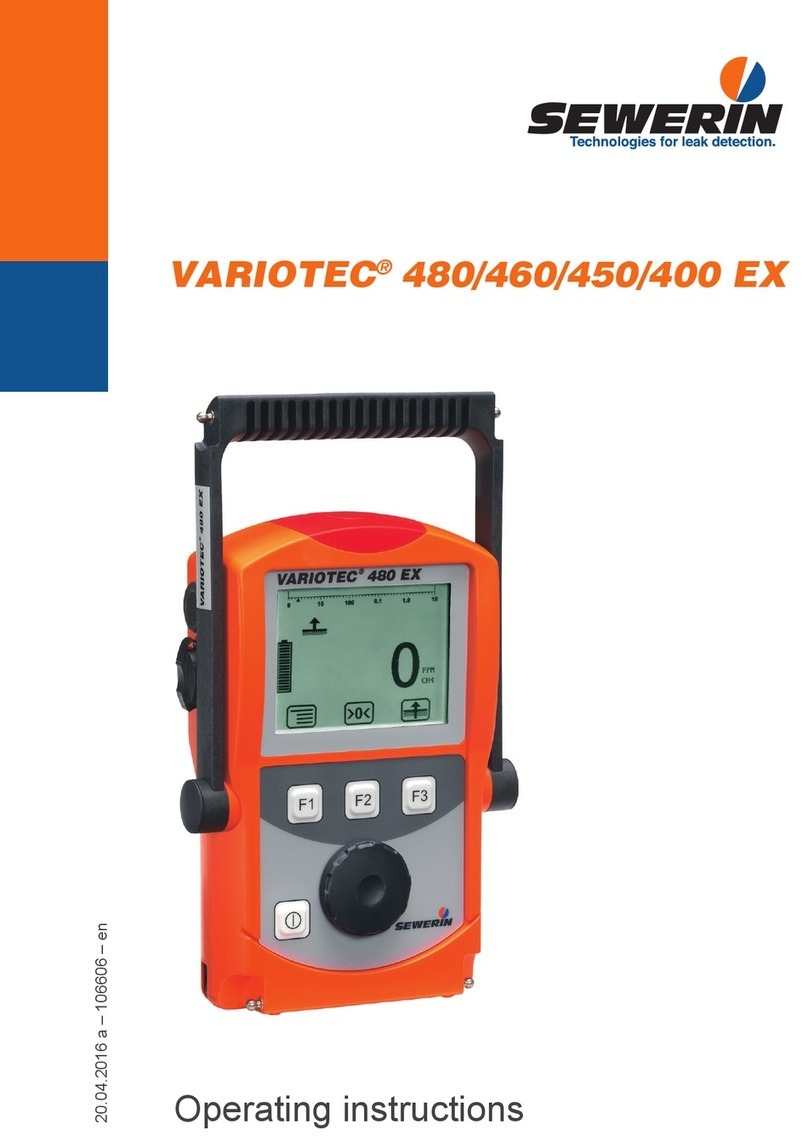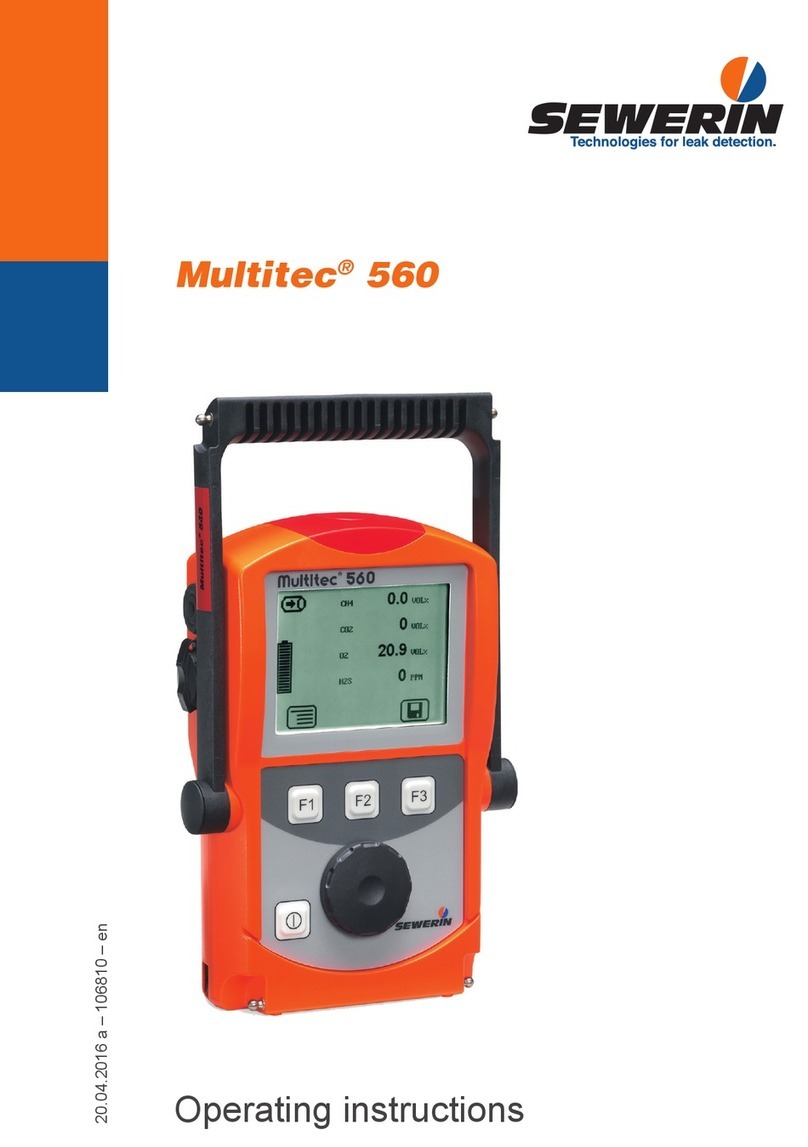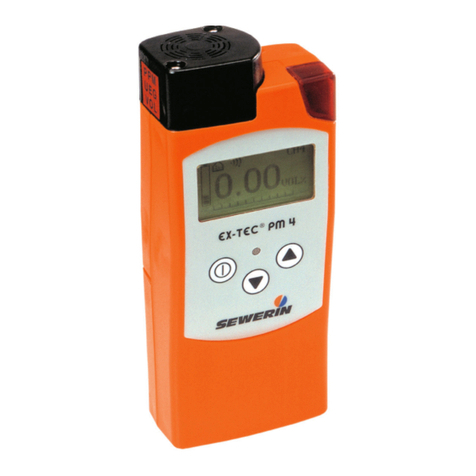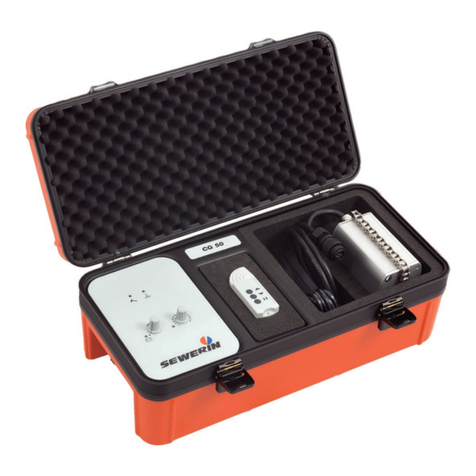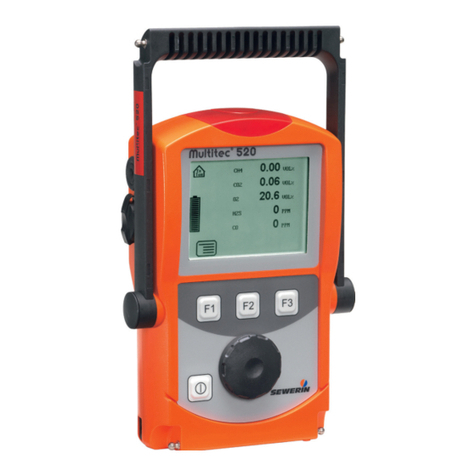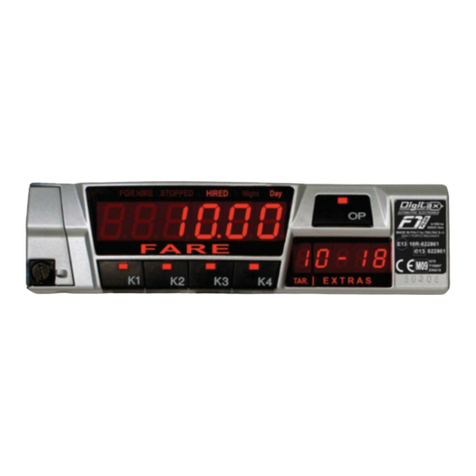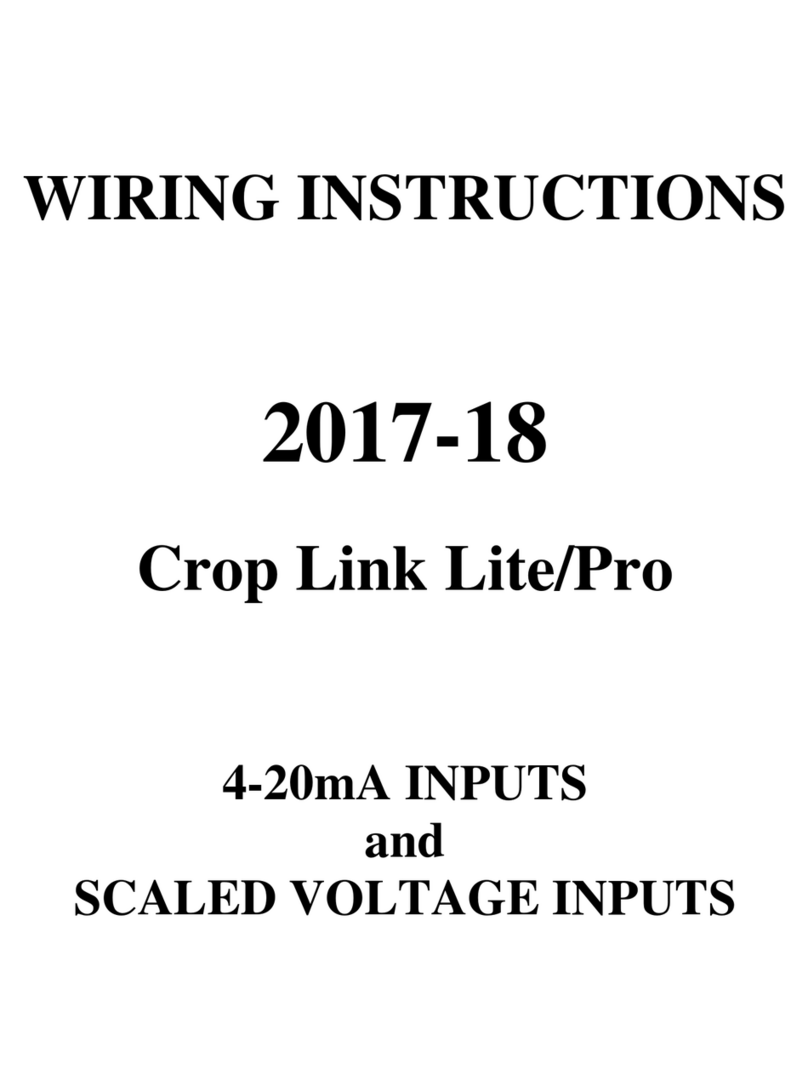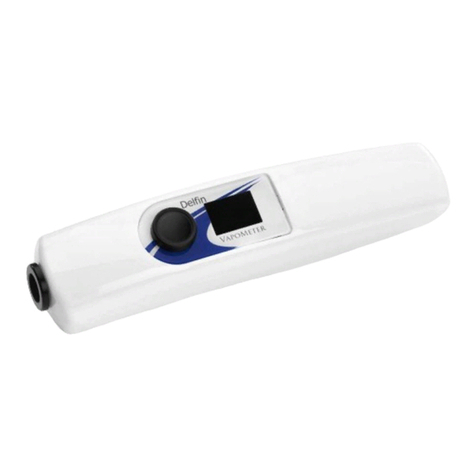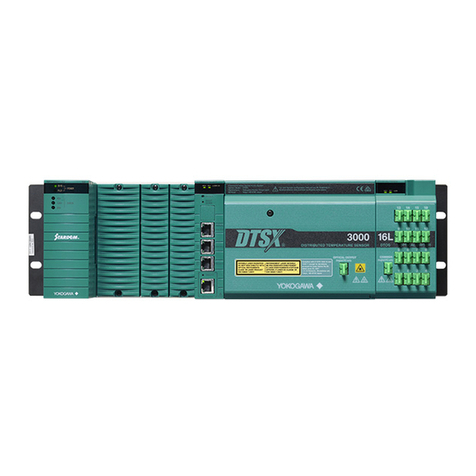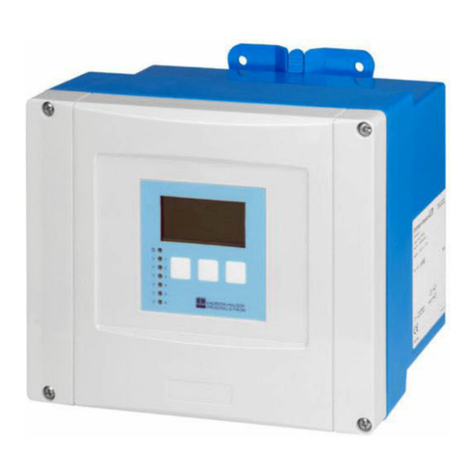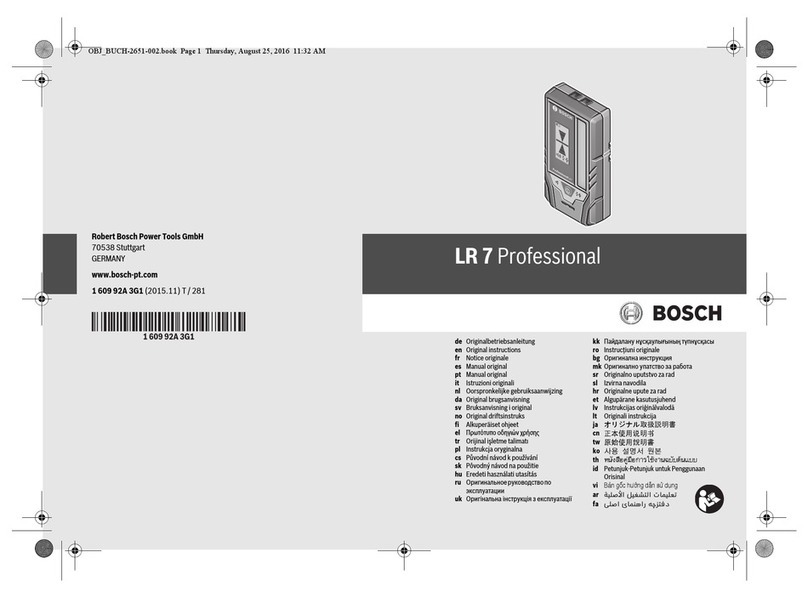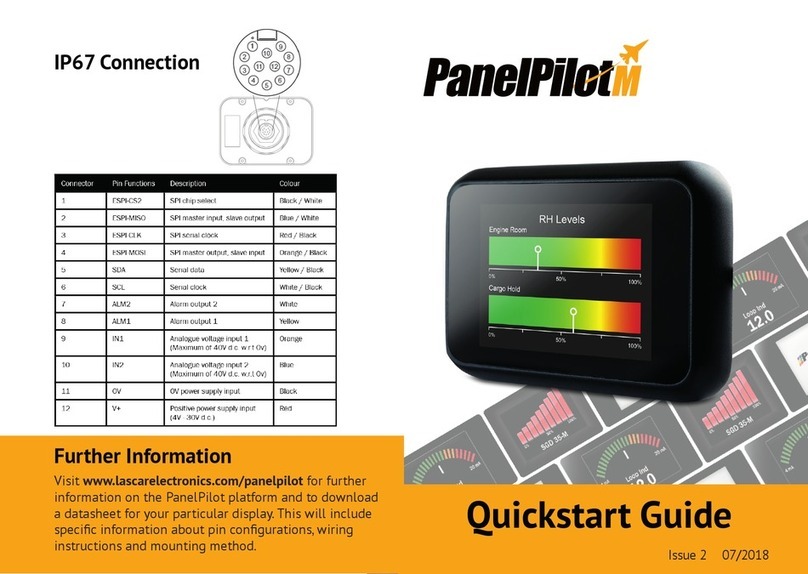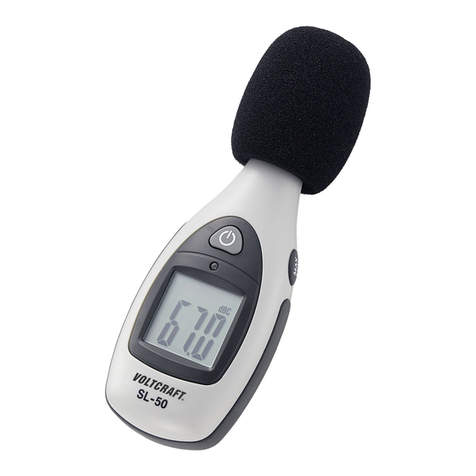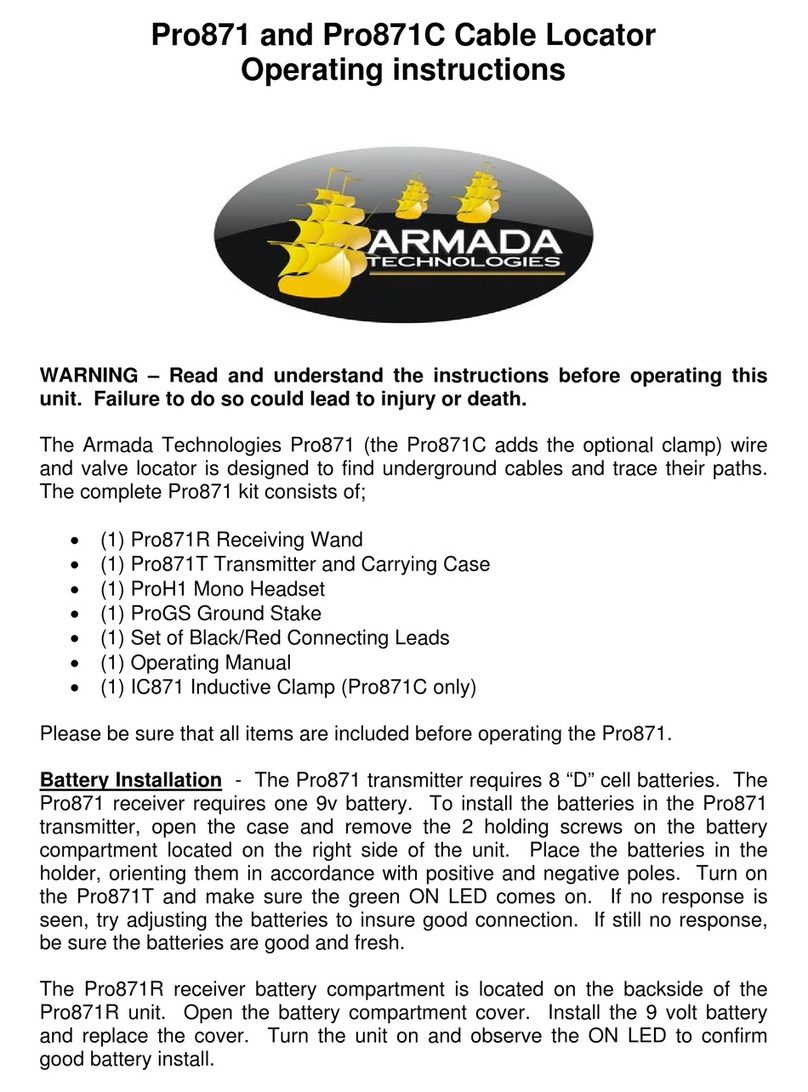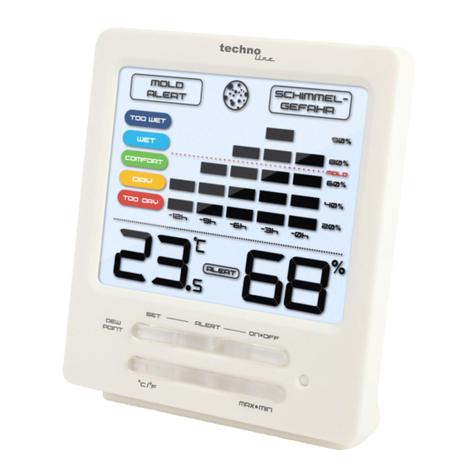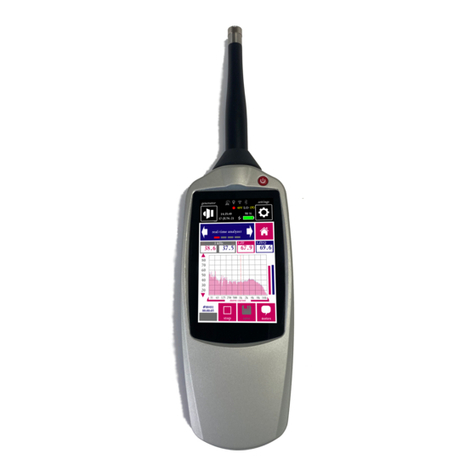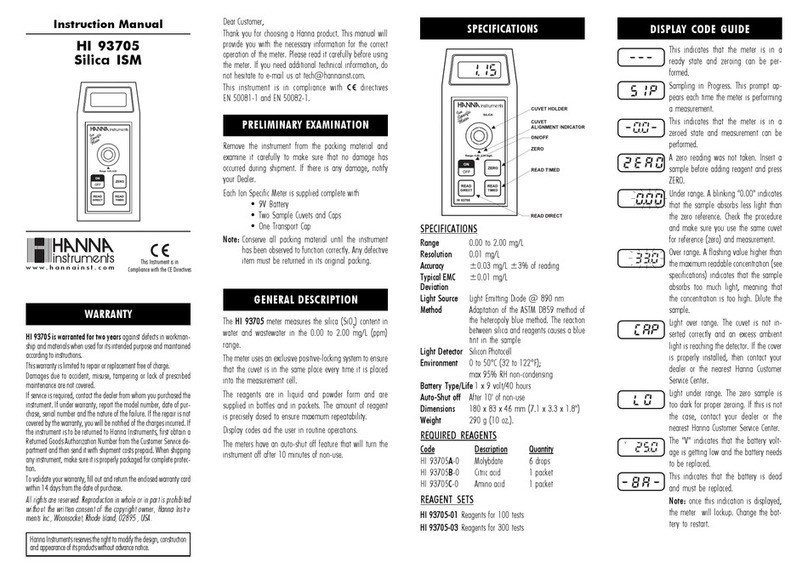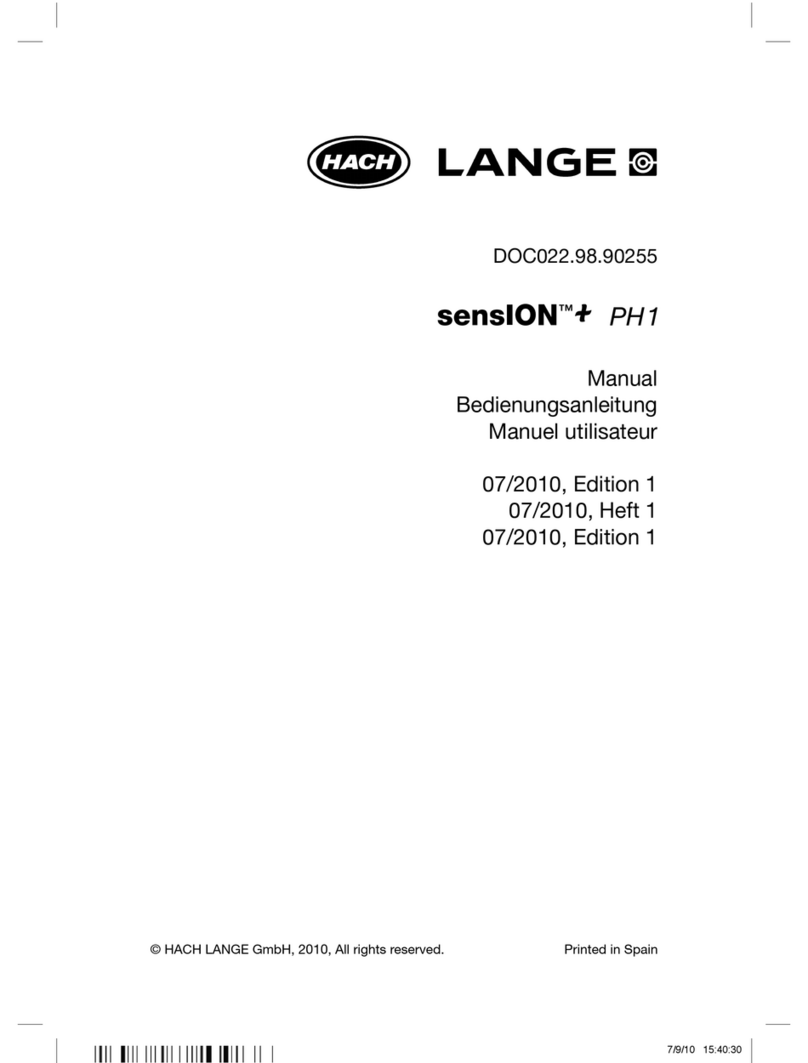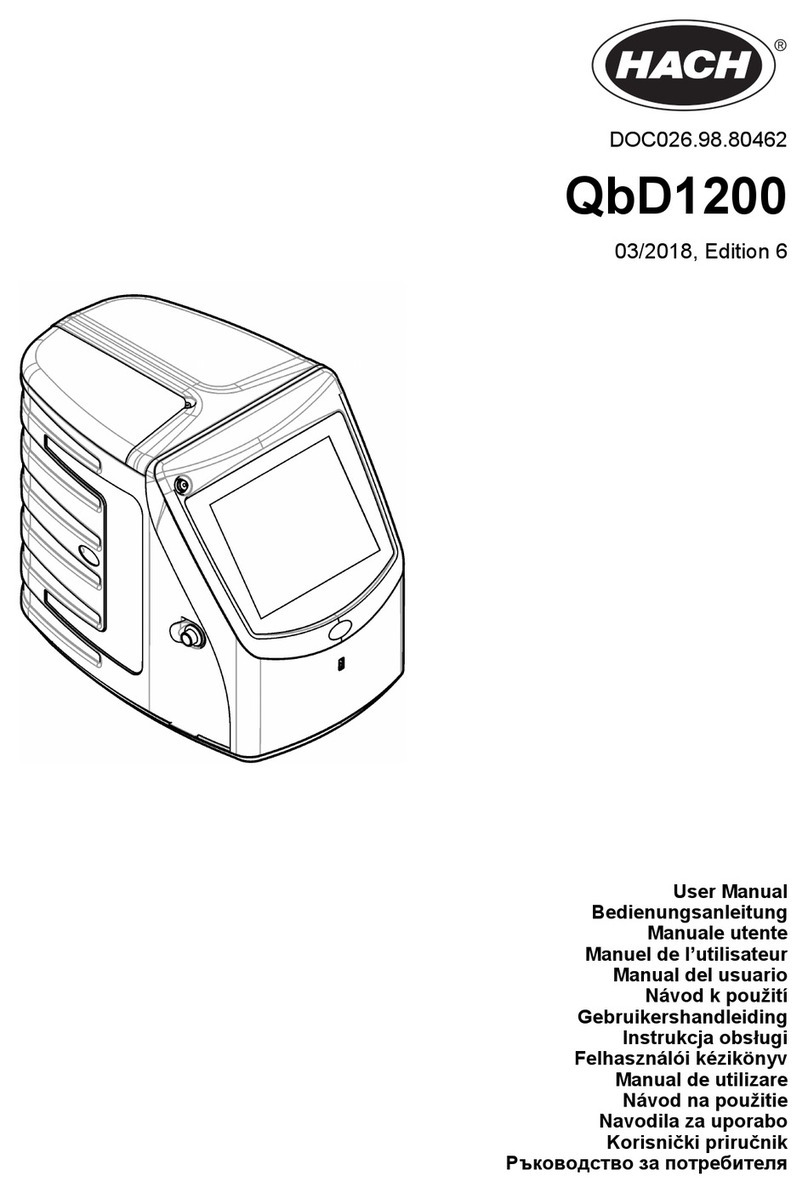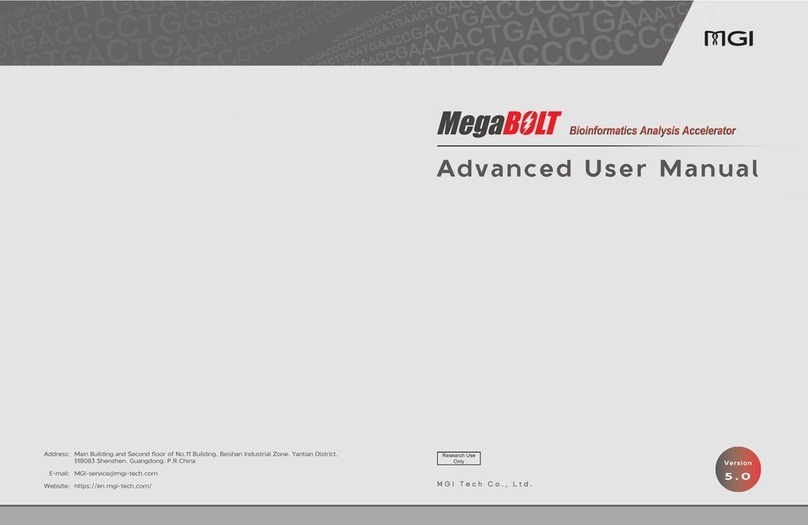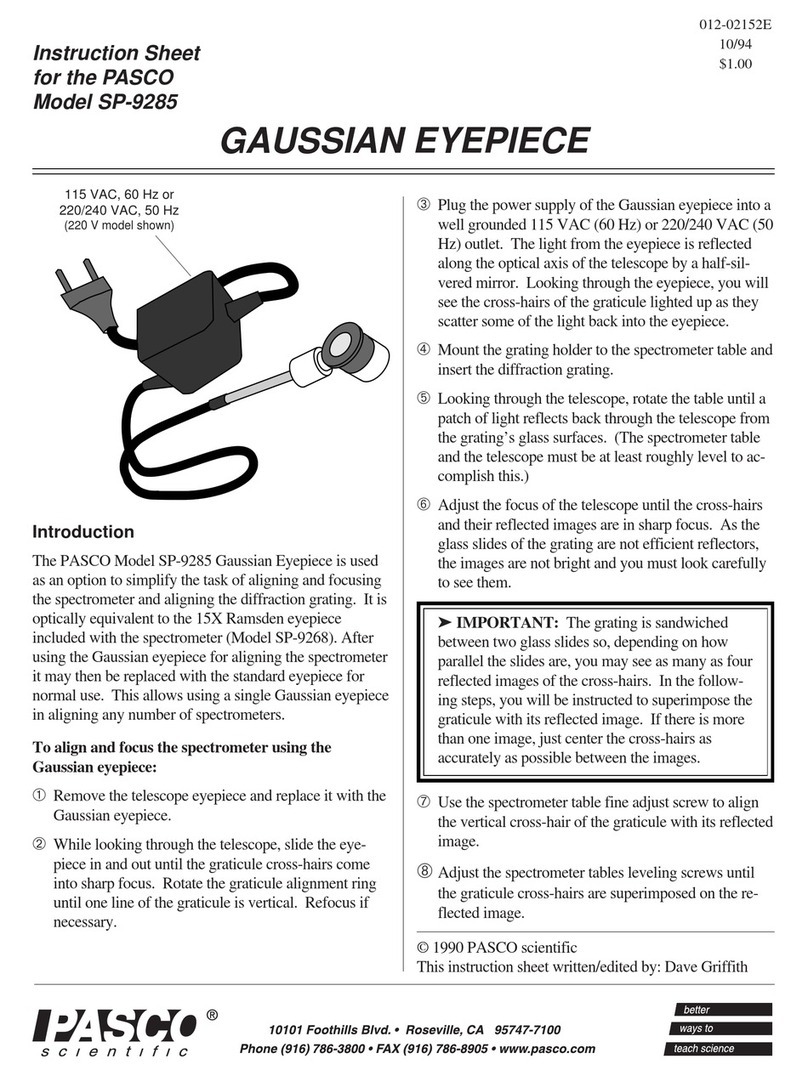sewerin VARIOTEC 460 Tracergas User manual

VARIOTEC®460 Tracergas
Operating instructions
20.04.2016 a – 106924 – en

Connector
Buzzer
USB port
ON/OFF key
Connection for
power supply
Signal light
Gas input
Function keys
Jog dial
Connector
Display
Measured value
Battery
capacity
Selected
application
Bar graph
Alarm
Unit
Gas type
Current assignment of
function keys F1 – F3
Supporting bracket
Fig. 1: VARIOTEC 460 Tracergas device overview
Fig. 2: VARIOTEC 460 Tracergas display
VARIOTEC®460 Tracergas

General
Menu Fault
OK Perform device inspection
Esc
Cancel Tab (jump to next input eld)
Buzzer off
0
Set zero point
Stop measurement Information
Clear Open stored comments
Open stored inspectors
Battery capacity
Applications
Inspection above ground House
Measuring in bar holes Gas measuring
Display symbols

Information about this document
The symbols used in the document mean the following:
ANOTICE!
Indicates a hazardous situation for the product, which could
result in functional disturbance, damage or destruction.
ACAUTION!
Indicates a hazardous situation for users, which could present
health risks or result in bodily injury.
AWARNING!
Indicates a hazardous situation for users, which could result in
serious injury or death.
Note:
Indicates tips and useful information.
Instructions that must be followed in a specic sequence are numbered:
1. First action
2. Second action
a) Step one
b) Step two
Lists and instructions comprising only one action are indicated as follows:
●List point A
●List point B
−Subordinated list point

I
Contents Page
1 General.....................................................................................1
1.1 Warranty ...................................................................................1
1.2 Purpose.....................................................................................2
1.3 Intended use .............................................................................3
1.4 General safety information ........................................................4
1.5 Allocation of tasks to applications .............................................5
1.6 Tracer gas method ....................................................................6
2 Features ...................................................................................7
2.1 Visual and audible signals.........................................................7
2.2 Sensors .....................................................................................8
2.3 Explosion protection..................................................................9
3 Operation ...............................................................................10
3.1 General information on operation............................................10
3.1.1 Keys and jog dial..................................................................10
3.1.2 Selecting/exiting menus and menu items.............................10
3.1.3 Switching the device on ....................................................... 11
3.1.4 Selecting/switching applications...........................................13
3.1.5 Differences between measuring mode and settings mode ..14
3.2 Measuring mode .....................................................................14
3.2.1 Accessing the menu (measuring mode menu structure)......15
3.2.2 Zero point .............................................................................15
3.2.3 Inspection above ground......................................................17
3.2.4 Measuring in bar holes.........................................................18
3.2.5 House...................................................................................19
3.2.6 Gas measuring.....................................................................20
3.2.7 Settings ................................................................................21
3.2.8 Starting/stopping/saving a measurement.............................21
3.2.9 Protocols ..............................................................................24
3.2.10 Device inspection .................................................................24
3.2.11 Device information ...............................................................25
3.3 Settings ...................................................................................25
3.3.1 Opening settings ..................................................................25
3.3.2 Settings menu structure .......................................................27
3.3.3 Adjustment ...........................................................................28
3.3.4 System .................................................................................29
3.3.5 Alarms ..................................................................................30
3.3.6 Date/time..............................................................................30
3.3.7 Memory ................................................................................31

II
Contents Page
4 Power supply.........................................................................32
4.1 Suitable disposable/rechargeable battery types .....................32
4.2 Operation with rechargeable batteries ....................................33
4.2.1 Charging...............................................................................33
4.2.2 Rechargeable battery maintenance .....................................34
4.3 Battery alarm...........................................................................35
4.4 Replacing disposable/rechargeable batteries .........................35
5 Maintenance ..........................................................................36
5.1 Device inspection ....................................................................36
5.1.1 General information on the device inspection ......................36
5.1.1.1 Scope................................................................................36
5.1.1.2 Frequency .........................................................................36
5.1.1.3 Documentation..................................................................37
5.1.1.4 Integrated device inspection .............................................37
5.1.1.5 Order.................................................................................38
5.1.2 Performing the device inspection .........................................38
5.1.2.1 Accessing the device inspection .......................................38
5.1.2.2 Concluding the device inspection......................................39
5.1.3 Testing the general status ....................................................41
5.1.3.1 Housing.............................................................................41
5.1.3.2 Signals ..............................................................................41
5.1.3.3 Probe.................................................................................42
5.1.3.4 Filter ..................................................................................42
5.1.3.5 Pump.................................................................................42
5.1.4 Testing indication accuracy with supply of fresh air .............43
5.1.5 Testing indication accuracy with supply of test gas..............43
5.2 Adjustment ..............................................................................44
5.2.1 Scope ...................................................................................45
5.2.2 Suitable test gas concentrations ..........................................45
5.2.3 Preparation...........................................................................46
5.2.4 Performing the adjustment ...................................................46
5.2.4.1 Adjusting the zero point.....................................................46
5.2.4.2 Adjusting the sensitivity.....................................................47
5.3 Servicing .................................................................................48
6 Faults......................................................................................49
7 Appendix................................................................................50
7.1 Specications and permitted operating conditions..................50

III
Contents Page
7.2 Alarms .....................................................................................51
7.2.1 Features ...............................................................................51
7.2.2 Alarm thresholds (factory settings).......................................52
7.3 Limit values for the device inspection .....................................52
7.4 Memory capacity .....................................................................53
7.5 Sensors ...................................................................................54
7.5.1 Gas-sensitive semiconductor (SC) for H2............................54
7.5.2 Thermal conductivity sensor (TC) for H2.............................54
7.6 Technical information ..............................................................55
7.6.1 Sensitivity of the gas-sensitive semiconductor (SC) ............55
7.6.2 Electrostatic charge..............................................................55
7.6.3 Identication sticker (back of device) ...................................55
7.6.4 Cleaning ...............................................................................56
7.7 Accessories and consumables................................................57
7.8 EU declaration of conformity ...................................................58
7.9 Inspection protocol ..................................................................59
7.10 Advice on disposal ..................................................................60
7.11 Terminology and abbreviations ...............................................61
7.12 Referenced documents ...........................................................61
8 Index.......................................................................................62

1
1 General
1 General
1.1 Warranty
The following instructions must be complied with in order for any
warranty to be applicable regarding functionality and safe opera-
tion of this equipment. This product must only be commissioned
by qualied professionals who are familiar with the legal require-
ments (Germany: DVGW).
●Read these operating instructions prior to operating the product.
●Use the product only as intended.
●Repairs and maintenance must only be carried out by special-
ist technicians or other suitably trained personnel. Only spare
parts approved by Hermann Sewerin GmbH may be used when
performing repairs.
●Use only suitable battery types, otherwise the device will not
be explosion-proof.
● Changes or modications to this product may only be carried
out with the approval of Hermann Sewerin GmbH.
●Use only Hermann Sewerin GmbH accessories for the product.
Hermann Sewerin GmbH shall not be liable for damages resulting
from the non-observance of this information. The warranty con-
ditions of the General Terms and Conditions (AGB) of Hermann
Sewerin GmbH are not affected by this information.
In addition to the warnings and other information in these Operat-
ing Instructions, always observe the generally applicable safety
and accident prevention regulations.
The manufacturer reserves the right to make technical changes.

2
1 General
1.2 Purpose
The VARIOTEC 460 Tracergas is a portable measuring device
for measuring the concentration of hydrogen in air or nitrogen.
The device is especially suitable for:
●Leak detection in pipes using hydrogen
Both gas and water pipes can be inspected. Water pipes must
not contain water at the time of inspection.
● Leak tests using the tracer gas method (e.g. in lling stations)
●Measuring the hydrogen content in air or nitrogen
All tasks that can be performed with the device are assigned to
applications. For more detailed information please see Section 1.5
on page 5.
AWARNING!
The VARIOTEC 460 Tracergas is not a gas warning in-
strument.
●Do not use the device to warn against dangerous gas
concentrations.
Note:
These operating instructions describe the functions of rmware
version 1.XXX. The manufacturer reserves the right to make
changes.
All descriptions refer to the device as delivered (factory settings).

3
1 General
1.3 Intended use
This device is intended for professional residential and commercial
use, in small rms and commercial operations and in industry. The
appropriate specialist knowledge is required to operate the device.
The device is intended for measuring hydrogen H2.
It should not be used for:
●Measuring toxic and corrosive gases
●Monitoring liquids
●Warning against explosive gas concentrations (operator pro-
tection)
The device can be used up to a temperature of 40 ºC. However,
high temperatures reduce the lifetime of the rechargeable bat-
teries.

4
1 General
1.4 General safety information
●The device has been tested to ensure that it is explosion-proof
in accordance with European standards (CENELEC).
●The device is explosion-proof for tracer gas only up to a maxi-
mum hydrogen content of 5% in air or nitrogen. If the hydrogen
content in air or nitrogen exceeds 5%, the device must be used
in carrying bag TG8.
●SEWERIN recommends always using the device in carrying
bag TG8 in enclosed spaces.
●Do not use this device in oxygen-enriched atmospheres, oth-
erwise it will not be explosion-proof.
● Only probe hoses with a hydrophobic lter may be used.
Exception:
If the probe has a built-in hydrophobic lter, the hose does not
require any other lters.
●Devices may only be tested with test gases in well ventilated
areas or outdoors. Test gases must be handled in a profes-
sional manner.
●Always carry out a device inspection (see Section 5.1 on
page 36) after the device has suffered an impact (for exam-
ple, if dropped accidentally).
●The device complies with the limits of the EMC directive. Always
observe the information in the manuals of (mobile) radio equip-
ment when using the device close to (mobile) radio equipment.
ANOTICE!
Follow the advice regarding explosion protection (see
Section 2.3 on page 9).

5
1 General
1.5 Allocation of tasks to applications
The device is used in measuring mode in four applications:
●Inspection above ground
●Measuring in bar holes
●House
●Gas measuring
Owing to the high sensitivity in the ppm range, the Inspection
above ground and House applications are particularly suitable
for leak detection but less so for reproducible measurements.
The table is designed to help you decide which application to
choose for which activity (in accordance with /1/).
Location Task Application
●Poorly accessible
gas pipes
– underground
– laid in oors
●Measuring very low gas concen-
trations:
– above ground or above the oor
– above possible leakage points
Inspection
above ground
●In the ground ●Measuring the gas concentration
for:
– Determining gas dispersion
(detection limit)
– Locating a probable gas escape
(repair point)
– Preventing possible dangers
Measuring in
bar holes
●In the house
●Freely accessible
pipes
●Industrial plants
●Test laboratories
●Measuring very low gas concen-
trations
●Locating the source of gas
●Finding leaks at internal connec-
tions
●Leak testing of industrial compo-
nents
House
●Pipes
●Gas systems
●Measuring the gas concentration
●Purging (to demonstrate purity or
absence of gas, e.g. when com-
missioning/decommissioning gas
systems)
Gas
measuring

6
1 General
1.6 Tracer gas method
ANOTICE!
This section provides only a brief overview of the tracer gas
method. Using the tracer gas method correctly requires
extensive specialist knowledge.
The tracer gas method can be used for leak detection and for
leakage tests.
The method uses a nitrogen/hydrogen gas mixture (tracer gas)
consisting typically of 5% hydrogen and 95% nitrogen. Gas mix-
tures containing 10% hydrogen and 90% nitrogen can also be
used, however.
Owing to its physical properties, hydrogen has the ability to pen-
etrate other materials (e.g. screed, concrete). This penetrating
power is used to locate gas leaks in closed systems with a gas
measuring device such as the VARIOTEC 460 Tracergas.
Such closed systems may either already exist (e.g. lling stations)
or may have to be created. In the latter case the pipe sections
to be inspected are closed off with blind anges, for example.
Although pure hydrogen is extremely ammable, tracer gas is
non-combustible, non-corrosive and non-toxic. Hydrogen is ap-
proved as a food additive (E949), making the tracer gas method
suitable for inspecting water pipes.

7
2 Features
2 Features
2.1 Visual and audible signals
The device features two alarms:
● Signal light on top of device (visual signal)
● Buzzer on side of device (audible signal)
If this symbol appears on the display, the audible
signal can be switched off.
When an audible signal has been switched off it
cannot be switched back on while the concentration
level remains above the alarm threshold.
This symbol appears at the top left of the display as
soon as the audible signal has been switched off. It
disappears automatically if the level falls below the
alarm threshold.
Alarm
If the measured hydrogen gas concentration exceeds specied
limit values (alarm thresholds) the device gives a warning. It emits
both audible and visual signals.
The device has two alarms:
●ALPPM (adjustable alarm in the ppm range)
●ALEOS (alarm at the end of the measuring range)
Note:
Alarms are only emitted in the Inspection above ground and
House applications.
There are no alarms in the Measuring in bar holes and Gas
measuring applications.
The ALPPM alarm signal cycles between on and off. The ALEOS
alarm signal comprises a continuous tone and a steady light.
There is detailed information on alarms in Section 7.2 on
page 51.

8
2 Features
Dynamic or constant signal for ALPPM
For the ALPPM alarm there are two options for cycling the audi-
ble and visual signals:
●dynamic (dynamic signal)
●constant
With the dynamic signal option the cycle speed is dependent on
the measured gas concentration. The higher the concentration
above the alarm threshold, the shorter the interval between two
signals. This applies up to a concentration of 5 % vol. H2. Above
a concentration of 5 % vol. H2 the cycle speed remains constant.
With the constant signal option the cycle speed is always inde-
pendent of the measured gas concentration. The interval between
two signals is always constant.
The default setting at delivery is dynamic signal. If the dynamic
signal option is switched off, the device automatically switches
to a constant signal.
See Section 3.3.5 on page 30 for information on how to switch
off the dynamic signal.
2.2 Sensors
The device features two types of sensor:
● Gas-sensitive semiconductor (SC) for hydrogen
● Thermal conductivity sensor (TC)
Application Measuring range (H2) Sensors
Inspection above
ground
0.0 ppm — 5 % vol. SC, TC
Measuring in bar holes 0.0 % vol. – 100 % vol. TC
House 0.0 ppm — 5 % vol. SC, TC
Gas measuring 0.0 % vol. – 100 % vol. TC

9
2 Features
2.3 Explosion protection
The device is assigned to the following explosion-proof groups:
Explosion-proof
group
For the following at-
mospheres
When using
II2G Ex d e ib IIB T4 Gb ●Methane CH4
●Propane C3H8
●Butane C4H10
●Tracer gas with max.
5% H2in N2
Device with-
out carrying
bag TG8
II2G Ex d e ib IIC T4 Gb ●Methane CH4
●Propane C3H8
●Butane C4H10
●Hydrogen H2
●Tracer gas
Device with
carrying bag
TG8
EC type-examination certicate: TÜV 07 ATEX 553353 X
AWARNING!
It is essential to observe the following points to ensure that
the device is explosion-proof:
●Only ever open the battery compartment and recharge
the batteries outside of explosive areas.
●Only use the USB port outside of explosive areas.
●Always use the appropriate type of disposable/recharge-
able battery.
●To ensure that the device complies with explosion-proof
group IIC with hydrogen H2and tracer gas containing
more than 5% H2in N2, the device must be used in car-
rying bag TG8.

10
3 Operation
3 Operation
3.1 General information on operation
3.1.1 Keys and jog dial
The ON/OFF key is the only control on the device that does not
change its function.
When switched on, the device is operated using the jog dial and
function keys to navigate the display.
Control Action Function
ON/OFF key Press ●Switches the device on
●Switches the device off
Function keys
F1, F2, F3
Press ●Variable
●As indicated on the display at
the bottom of the screen
●Function keys may also have
no function assigned in some
cases
Jog dial Turn ●Selects functions, settings,
measurement data, etc.
● Modies values
Press ●Opens the next program level
(e.g. menu item, function,
measurement data, selectable
values)
●Applies values
3.1.2 Selecting/exiting menus and menu items
Functions, applications and settings etc. are selected via the main
menu (for short: Menu). This menu has submenus and menu
items. Refer to Section 3.2.1 on page 15 for information on
accessing the main menu.

11
3 Operation
Selecting submenus/menu items
Submenus and menu items are selected and opened using the jog
dial and/or the function keys (see Section 3.1.1 on page 10).
The name of the selected menu or menu item is always shown
at the top left of the display.
In measuring mode the name of the selected application is in-
dicated by the symbol at the top left of the display. You can nd
detailed information on selecting and switching applications in
Section 3.1.4 on page 13.
Exiting menus/menu items
There are generally two ways to exit open menus/menu items
and return to the next level up:
●Press Esc
●Select Exit from the menu
3.1.3 Switching the device on
Note:
Always switch the device on with fresh air.
1. Press the ON/OFF key. The device switches on.
A visual and audible signal conrms that the device has been
switched on. The display and the pump come on.
The start screen appears on the display.
Fig. 3: Start screen
Display:
– Device type:
VARIOTEC 460 Tracergas
– User:
Frank Smith
City Council
Leakage Delivery
– Firmware version: V1.000
– Date and time

12
3 Operation
Then the opening screen for the selected application appears
(see Section 3.3.4 on page 29).
Fig. 4: Opening screen for In-
spection above ground
application
Display:
– Gas type: H2
– Application as symbol (top left)
and text:
Inspection above ground
– Measuring range:
0.0 ppm – 5 % vol.
– Alarm threshold:
ALPPM 0.5 ppm
– Symbol for next application that
can be selected via function
key F3: Measuring in bar holes
The device switches to measuring mode. The device warms
up. The reading ashes.
While the device is warming up, the prompt Add fresh air! is
displayed as a reminder.
2. Make sure the device is actually drawing in fresh air. Change
its location if necessary.
3. Wait until the reading stops ashing.
The device is ready for use.
Fig. 5: Inspection above ground
measuring mode
Display:
– Current reading: zero when
device is switched on with fresh
air

13
3 Operation
3.1.4 Selecting/switching applications
Note:
You may only switch applications when the device is drawing in
fresh air.
The current application is indicated by the symbol at the top left
of the display. The symbol at the bottom right shows the next ap-
plication that can be selected via function key F3. You can specify
which application is activated rst when the device is switched on
in the Settings under System (see Section 3.3.4 on page 29).
●Press Menu. Select the menu item for the application you
want to use.
OR
a) Press function key F3. The device switches to the next ap-
plication.
b) Repeat until the symbol for the application you want to use
appears at the top left.
Table of contents
Other sewerin Measuring Instrument manuals
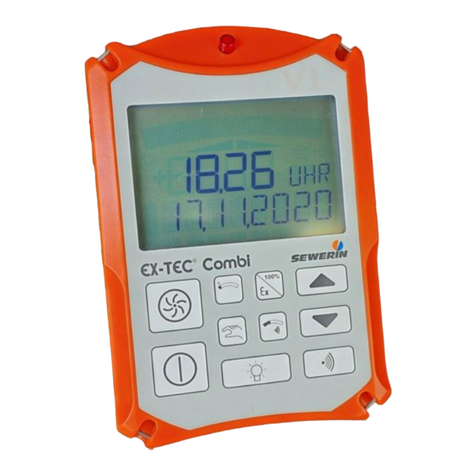
sewerin
sewerin EX-TEC Combi User manual
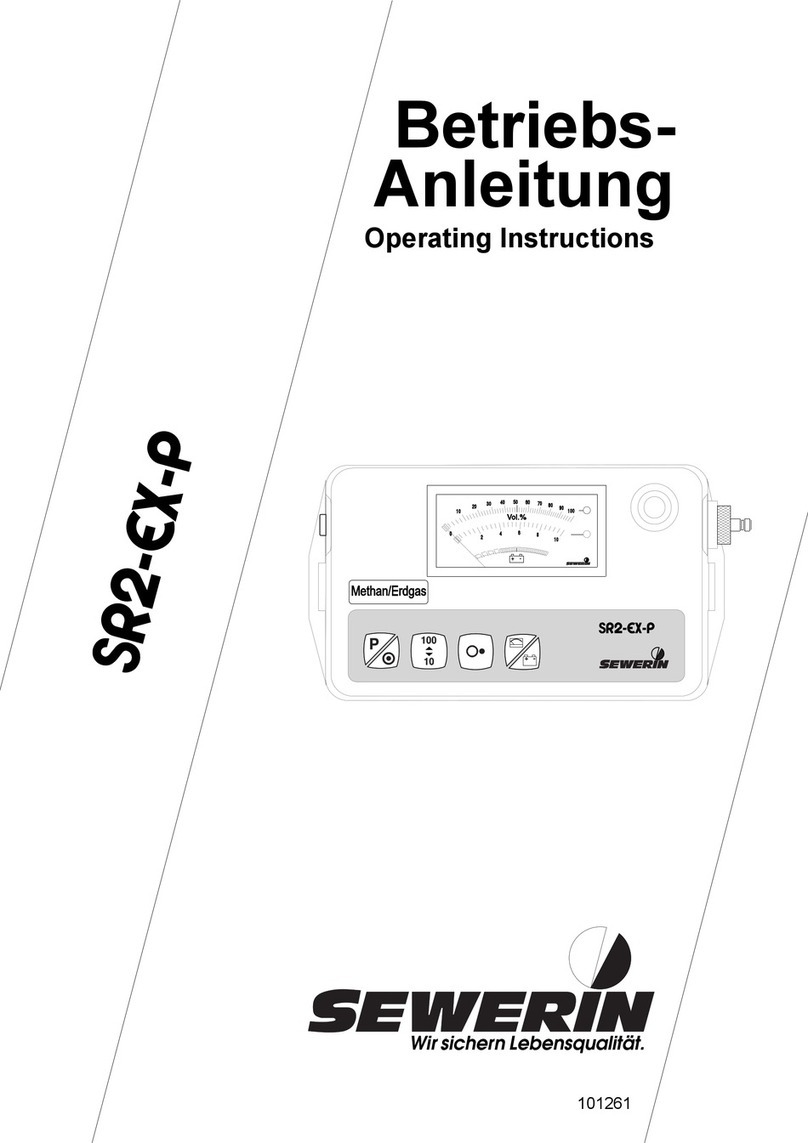
sewerin
sewerin SR2-EX-P User manual

sewerin
sewerin Multitec 545 User manual
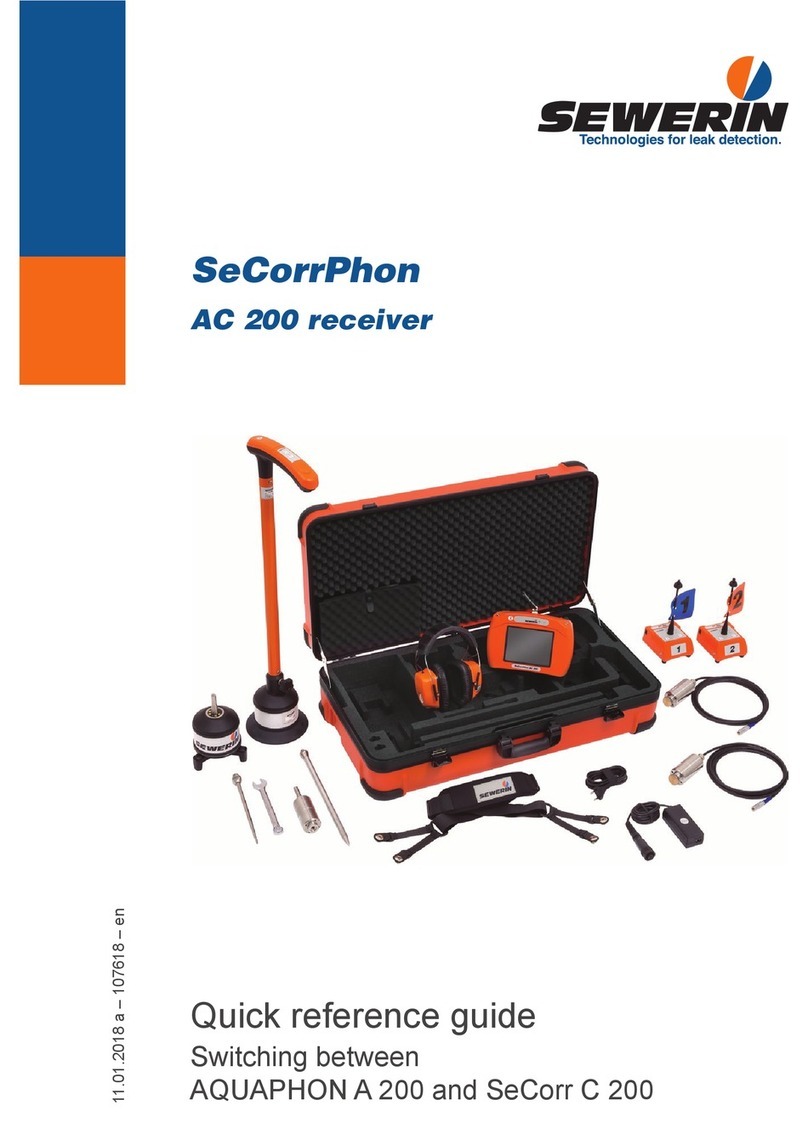
sewerin
sewerin SeCorrPhon AC 200 User manual
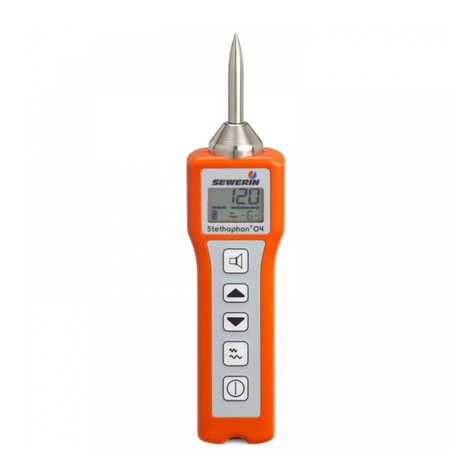
sewerin
sewerin Stethophon 04 User manual
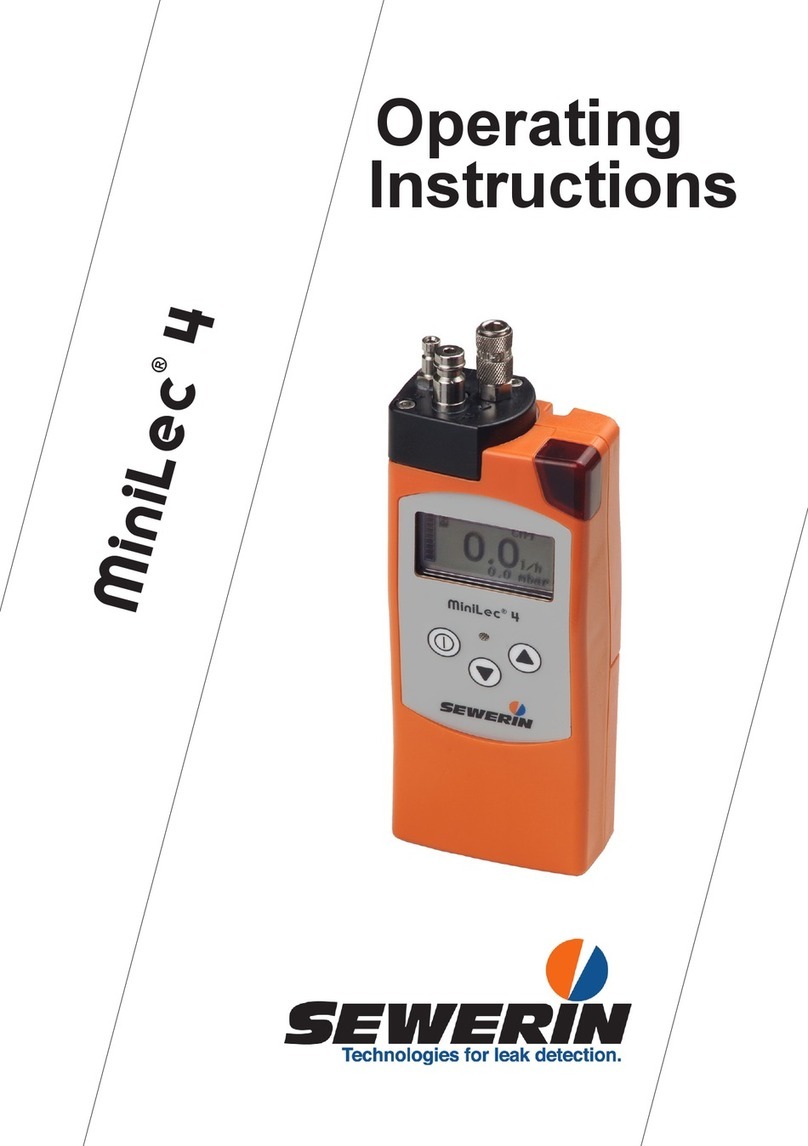
sewerin
sewerin miniLec 4 User manual
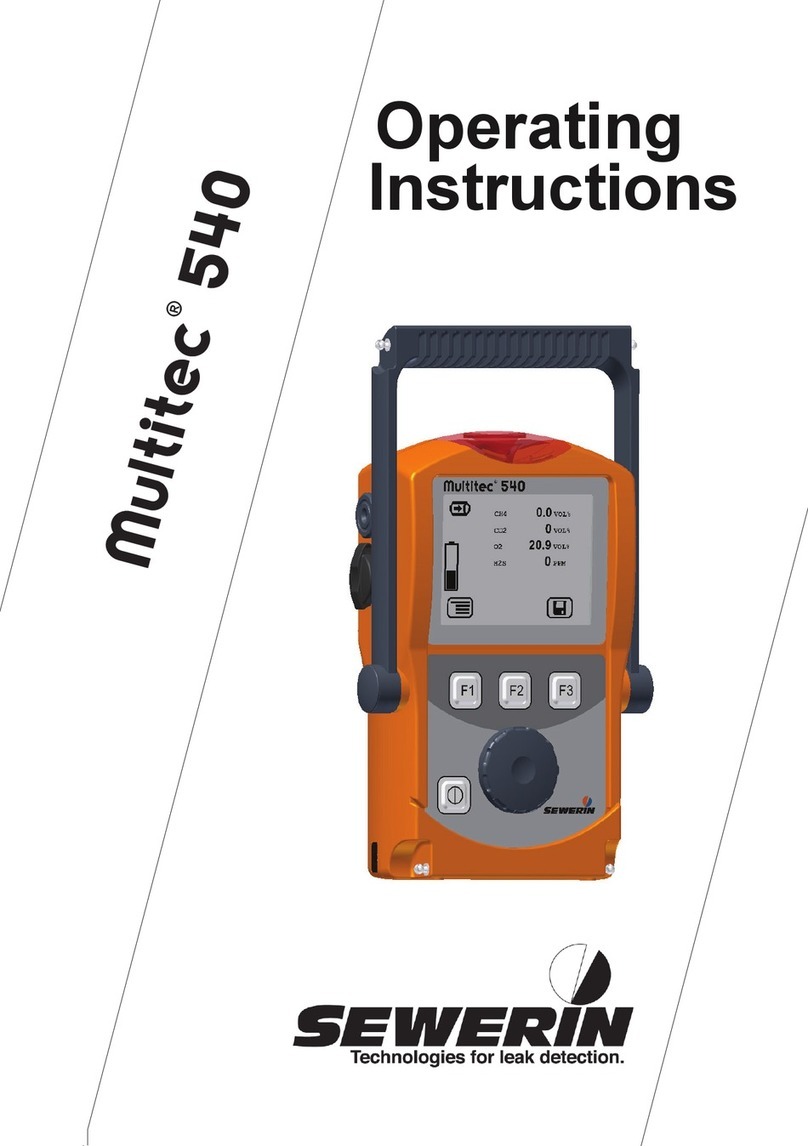
sewerin
sewerin Multitec 540 User manual
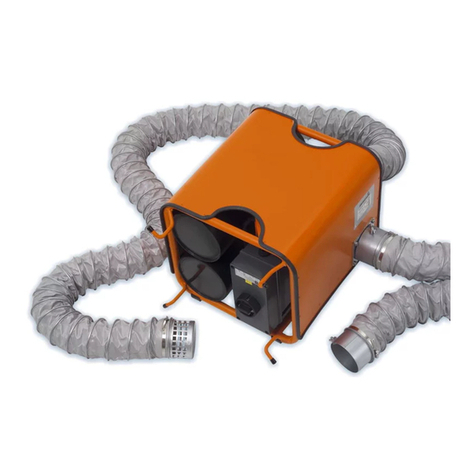
sewerin
sewerin FLIS-EX User manual
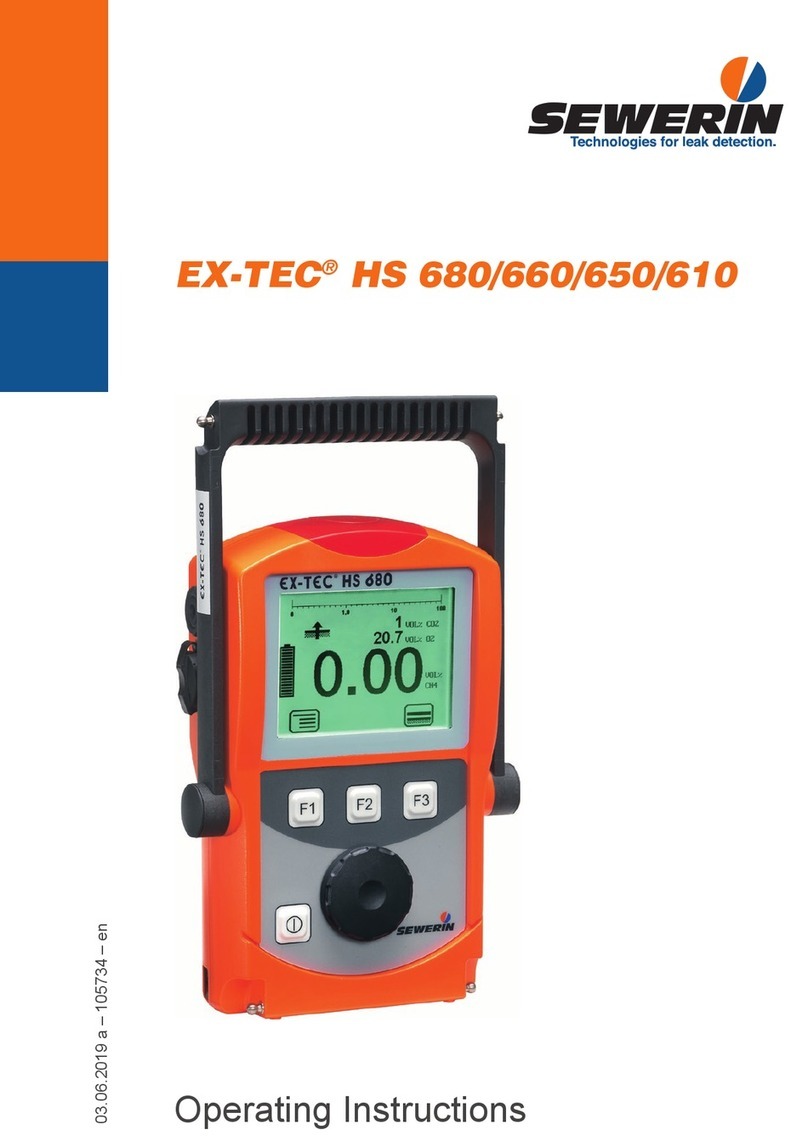
sewerin
sewerin EX-Tec HS 680 User manual
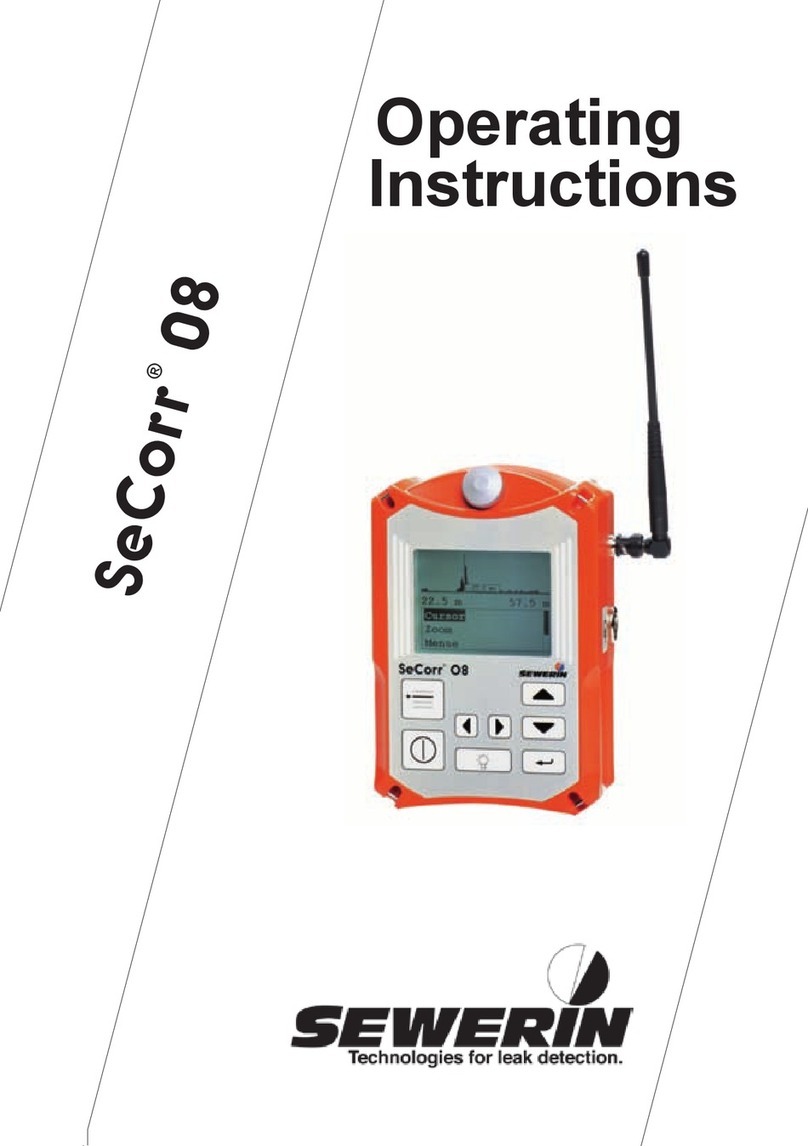
sewerin
sewerin SeCorr 08 User manual
